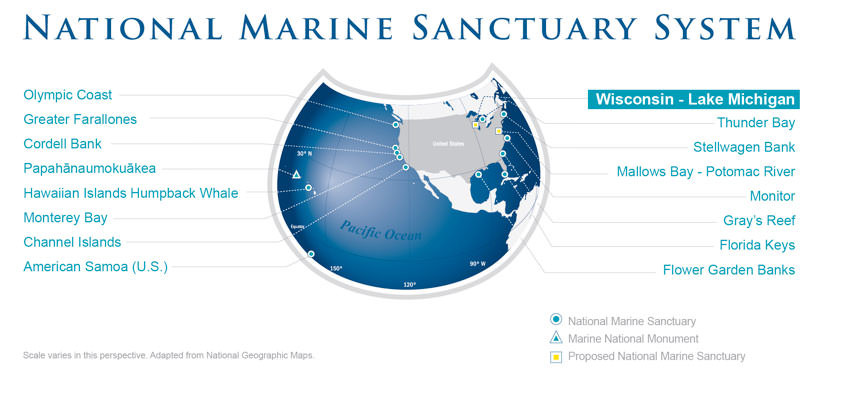“The establishment of a federally managed marine sanctuary accomplishes something we all can agree on: a collaborative, locally led, public-private effort to protect our environment.” Sen. Ron Johnson (R-Wis.)
 Wisconsin is once again at the forefront of water resource protection. For the first time since 2000, the National Oceanic and Atmospheric Administration (NOAA) announced its intent to designate new sanctuaries under the National Marine Sanctuaries Act, and 875 miles of Lake Michigan’s shoreline are among two sites being considered for sanctuary status. The nomination was announced by President Barack Obama at the 2015 Our Ocean Conference in Chile on October 5, 2015. The announcement recognized the importance of protecting water resources and highlighted the interrelationship between historic and natural resources.
Wisconsin is once again at the forefront of water resource protection. For the first time since 2000, the National Oceanic and Atmospheric Administration (NOAA) announced its intent to designate new sanctuaries under the National Marine Sanctuaries Act, and 875 miles of Lake Michigan’s shoreline are among two sites being considered for sanctuary status. The nomination was announced by President Barack Obama at the 2015 Our Ocean Conference in Chile on October 5, 2015. The announcement recognized the importance of protecting water resources and highlighted the interrelationship between historic and natural resources.
The proposed Wisconsin – Lake Michigan sanctuary extends from Port Washington to Two Rivers and contains an extraordinary collection of thirty-nine known shipwrecks dating between 1833 and 1918, fifteen of which are listed on the National Register of Historic Places. Fourteen of the known shipwrecks are essentially intact and three vessels possess standing masts, a rarity in the Great Lakes. The area also includes Wisconsin’s two oldest known shipwrecks and its most famous: the Rouse Simmons, a three-masted schooner known as the “Christmas Tree Ship” that sank off Two Rivers in 1912.
The nomination submission was one of seven received by NOAA since it opened up the nomination process last year. Wisconsin’s nomination was endorsed by a diverse coalition of organizations and individuals, including elected officials, historical societies, businesses, museums, and environmental, recreational, conservation, fishing, tourism, and educational groups. The proposed designation will be open for public comment through January 15, 2016, and several public meetings will be held next month to discuss the proposal. For more information about the nomination and dates and times for public meetings, please visit the NOAA nomination page here: http://sanctuaries.noaa.gov/wisconsin/.
NOAA’s marine sanctuary system encompasses more than 170,000 square miles of US ocean and Great Lakes waters and protects both thriving ecosystems and heritage sites. There are currently fourteen designated marine sanctuaries, including one other in the Great Lakes, the Thunder Bay National Marine Sanctuary in Lake Huron. Designated sanctuaries adhere to guideline standards of resource protection, research, and education.
A fourteen-mile stretch of the Potomac River’s Mallows Bay in Maryland is also currently under consideration for NOAA’s marine sanctuary designation. It will likely take two to three years to finalize the marine sanctuary status of either site.
For more information about the Wisconsin Historical Society’s Maritime Preservation and Archaeology Program, click here.